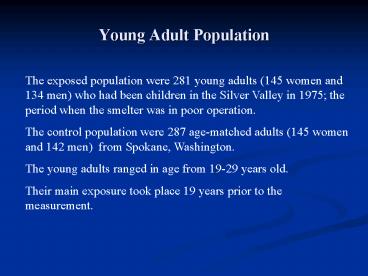Young Adult Population - PowerPoint PPT Presentation
1 / 21
Title:
Young Adult Population
Description:
Class mid-point the value of the variable midway between the true lower and upper class limits ... are also called lower and upper quartile, respectively. ... – PowerPoint PPT presentation
Number of Views:19
Avg rating:3.0/5.0
Title: Young Adult Population
1
Young Adult Population
The exposed population were 281 young adults (145
women and 134 men) who had been children in the
Silver Valley in 1975 the period when the
smelter was in poor operation. The control
population were 287 age-matched adults (145 women
and 142 men) from Spokane, Washington. The young
adults ranged in age from 19-29 years old. Their
main exposure took place 19 years prior to the
measurement.
2
Definitions
- variables (age, sex, city of birth, etc.)
- data the values taken by the variables
- data and variables can be quantitative or
qualitative
3
Frequency Distributions how to construct them,
how to read them.
4
Exposed versus Control
5
Frequency distributions
- For discrete variables, little grouping is
required - e.g. family size. It is easy to group the data
into - 0 children
- 1 child
- 2 children
- You could then look at whether families with zero
children buy less toys than families with any
children
6
Frequency distributions
- For continuous variables, you often need to group
or classify the data - Groups or classes should encompass the full
extent of the data - They should not be overlapping
- Generally, widths of all classes (class
intervals) should be identical - All recorded values must fit into one of the
tabulated classes - Class mid-pointthe value of the variable midway
between the true lower and upper class limits - For discrete variables, there are no class widths
7
Frequency distributions
- For continuous variables, you often need to group
or classify the data - Groups or classes should encompass the full
extent of the data - They should not be overlapping
- Generally, widths of all classes (class
intervals) should be identical - All recorded values must fit into one of the
tabulated classes - Class mid-pointthe value of the variable midway
between the true lower and upper class limits - For discrete variables, there are no class widths
8
Frequency distributions
- For continuous variables, you often need to group
or classify the data - Groups or classes should encompass the full
extent of the data - They should not be overlapping
- Generally, widths of all classes (class
intervals) should be identical - All recorded values must fit into one of the
tabulated classes - Class mid-pointthe value of the variable midway
between the true lower and upper class limits - For discrete variables, there are no class widths
9
Frequency distributions
- For continuous variables, you often need to group
or classify the data - Groups or classes should encompass the full
extent of the data - They should not be overlapping
- Generally, widths of all classes (class
intervals) should be identical - All recorded values must fit into one of the
tabulated classes - Class mid-pointthe value of the variable midway
between the true lower and upper class limits - For discrete variables, there are no class widths
10
Frequency distributions
- For continuous variables, you often need to group
or classify the data - Groups or classes should encompass the full
extent of the data - They should not be overlapping
- Generally, widths of all classes (class
intervals) should be identical - All recorded values must fit into one of the
tabulated classes - Class mid-pointthe value of the variable midway
between the true lower and upper class limits - For discrete variables, there are no class widths
11
Frequency distributions
- For continuous variables, you often need to group
or classify the data - Groups or classes should encompass the full
extent of the data - They should not be overlapping
- Generally, widths of all classes (class
intervals) should be identical - All recorded values must fit into one of the
tabulated classes - Class mid-pointthe value of the variable midway
between the true lower and upper class limits - For discrete variables, there are no class widths
12
Exposed versus Control
13
Measures of central value
- The arithmetic mean
- Usually what is called the average of a series of
numbers - Add up the values of each observation and divide
this total by the number of observations
14
Measures of central value
- The median
- The value of that observation which, when the
observations are arranged in the ascending (or
descending) order of magnitude, divides them into
two equal-sized groups - Order data, then find the middle value
- For symmetrical distributions, median and mean
are equal (rarely the case)
15
Exposed versus Control
16
Other measures of the frequency distribution
- Used to locate other points in the distribution
with respect to the central value - Obtained from the histogram
- 10th percentile 10 have value below this
figure, and 90 have value above this figure - 50th percentile is the mean
- 25th and 75th percentiles are also called lower
and upper quartile, respectively. Their
difference is called the interquartile range. - Difficult to estimate in practice when dealing
with small sample sizes
17
Exposed versus Control
18
Exposed Subjects
19
Comparison of Two Systems
20
Shapes of distributions
- Number of peaks unimodal (most common), bimodal,
etc. - Unimodal distributions
- Symmetrical
- Skewed
- Positively skewed long tail at the upper end
- Negatively skewed long tail at the lower end
21
Precision































